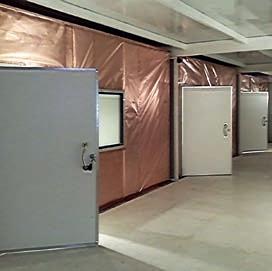
3 minute read
COPPER CULTURE
Why copper?
Many of us have had our body or part of it scanned by an MRI scanner. MRI stands for Magnetic Resonance Imaging and is one of the most accurate devices used in hospitals and medical clinics because of the sliced pictures of the human body and its organs and tissues that it creates.
We do not necessarily think about the device itself or its environment when we enter the MRI scanner “tube.” Usually the situation is exciting to us, and we are very nervous about the operation and especially the results.
It is, however, interesting to discover that the magnet is placed inside an RF shielded room, a so-called Faraday cage, in order to assure a safe environment for the measurement and high-quality images without radio frequency interference. The floor has to be extremely rigid to provide a steady platform for the heavy equipment, and there has to be some acoustic shielding provided as well since the magnet is very noisy when in operation.
In most cases these shielded enclosures are made of nonferromagnetic materials like copper or aluminium, but nowadays galvanised steel can also be used. In addition to the walls, floor and ceiling, the critical parts of any shield are the openings, such as doors and viewing windows and all the other feedthroughs as well (air, compressed air, electricity etc.). The supplier needs to know how to design the whole room so that these openings do not form weak points allowing for leakages at the required frequencies. Electrical continuity needs to be assured at every point so that the required 80–100 dB shielding effectiveness can be reached everywhere.

Copper assures reliable MRI-scan There are three primary reasons to use annealed copper as the RF shielding medium (the comparisons below are mainly done between copper and galvanised steel):
1. First is conductivity: Effectively, an RF shield is an electrically conductive circuit about a three-dimensional space (the room). The more conductive a material is, the better its shielding effectiveness. The primary RF conductor with a galvanised steel shield is the zinc coating on the base steel plate. Copper has a conductivity rating of 1.0, whereas zinc on the other hand has a conductivity of 0.26,

and that of aluminium is also clearly less than copper. The only metal that has a higher conductivity rating than copper is pure silver, with a rating of 1.05.
2. Second is corrosion: Most metals corrode, with gold being an exception. All RF shields are made up of joined metal sheets. It is very important that efforts are made to prevent corrosion, not so much on the metal surfaces but at the joints of the metal sheets that make up the overall RF shield. Copper corrodes to copper oxide. Copper oxide is electrically conductive. The RF joints in the modular copper shield are pure annealed copper to copper and are 1–3/4" wide. Corrosion at the panel joints made of copper will have little, if any, effect on the conductivity of the panel joints, thus maintaining the shielding effectiveness. Zinc, on the other hand, corrodes to zinc oxide, better known as white rust. Zinc oxide is a ceramic and electrically inert. As such, corrosion at the panel joints of a galvanised steel shield will reduce the overall shielding effectiveness due to a reduction in surface conductivity.
3. Third is gross surface contact area: Another reason why the copper shield is considered superior. When the panel joint faces form a large surface contact area, it provides superior electrical conductivity. The panels are also normally connected mechanically with through bolts placing the RF joint in compression, which affords much higher clamping pressures between the copper surfaces of adjoining panels. With the galvanised shield, the RF contact area is essentially just the edge of the 2" wide steel friction clamp. This produces a very narrow contact area. The framing clamp is a slip connection so that the panels are effectively held together by friction. If too much torque is used on the 1/4x20 screws that secure the clamps, the clamps will deform further, reducing the RF contact area. Another drawback is that the compression clamp will cut through the zinc plating and into the underlying base sheet steel. Additional corrosion can then occur on the base steel, compounding the reduction in overall conductivity.
It’s just amazing how much expertise, experience and detailed knowledge surrounds us in our everyday life to which we hardly ever pay attention! •







